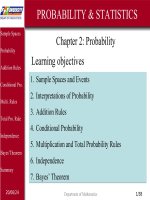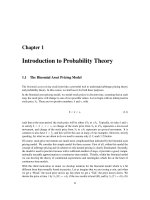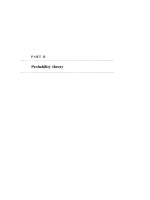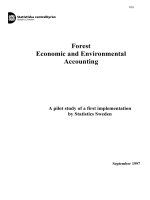PROBABILITY & STATISTICS
Bạn đang xem bản rút gọn của tài liệu. Xem và tải ngay bản đầy đủ của tài liệu tại đây (1007.6 KB, 39 trang )
Sample Spaces
Probability
Addition Rules
Conditional Pro.
Multi. Rules
Total Pro. Rule
Independence
Bayes’Theorem
Summary
1/38
15/06/13
Department of Mathematics
PROBABILITY & STATISTICS
Learning objectives
1. Sample Spaces and Events
2. Interpretations of Probability
3. Addition Rules
4. Conditional Probability
5. Multiplication and Total Probability Rules
6. Independence
7. Bayes’ Theorem
1. Sample Spaces and Events
2. Interpretations of Probability
3. Addition Rules
4. Conditional Probability
5. Multiplication and Total Probability Rules
6. Independence
7. Bayes’ Theorem
Chapter 2: Probability
Sample Spaces
Probability
Addition Rules
Conditional Pro.
Multi. Rules
Total Pro. Rule
Independence
Bayes’Theorem
Summary
2/38
15/06/13
Department of Mathematics
Sample spaces and events
Sample Spaces
Definition Random experiment
Definition Random experiment
•
An experiment that can result in different outcomes,
even though it is repeated in the same manner every
time, is called a random experiment.
•
The set of all possible outcomes of a random
experiment is called the sample space of the
experiment. The sample space is denoted as S.
•
An event is a subset of the sample space of a random
experiment.
•
An experiment that can result in different outcomes,
even though it is repeated in the same manner every
time, is called a random experiment.
•
The set of all possible outcomes of a random
experiment is called the sample space of the
experiment. The sample space is denoted as S.
•
An event is a subset of the sample space of a random
experiment.
Sample Spaces
Probability
Addition Rules
Conditional Pro.
Multi. Rules
Total Pro. Rule
Independence
Bayes’Theorem
Summary
3/38
15/06/13
Department of Mathematics
Sample spaces and events
Example
Example
Random experiment: Roll a die
Sample space: S ={1, 2, 3, 4, 5, 6}
Event: E
1
= {Die is even}={2, 4, 6}
E
2
= {Die is odd}={1, 3, 5}
Random experiment: Roll a die
Sample space: S ={1, 2, 3, 4, 5, 6}
Event: E
1
= {Die is even}={2, 4, 6}
E
2
= {Die is odd}={1, 3, 5}
Sample spaces
Sample Spaces
Probability
Addition Rules
Conditional Pro.
Multi. Rules
Total Pro. Rule
Independence
Bayes’Theorem
Summary
4/38
15/06/13
Department of Mathematics
Sample spaces and events
Tree Diagrams
Sample spaces can also be described graphically with
tree diagrams.
–
When a sample space can be constructed in several
steps or stages, we can represent each of the n
1
ways of completing the first step as a branch of a
tree.
–
Each of the ways of completing the second step
can be represented as n
2
branches starting from the
ends of the original branches, and so forth.
Sample spaces
Sample Spaces
Probability
Addition Rules
Conditional Pro.
Multi. Rules
Total Pro. Rule
Independence
Bayes’Theorem
Summary
5/38
15/06/13
Department of Mathematics
Sample spaces and events
Example
Example
A probability experiment consists of tossing a coin
and then rolling a six-sided die. Describe the
sample space.
A probability experiment consists of tossing a coin
and then rolling a six-sided die. Describe the
sample space.
Tree diagram:
H1 H2 H3 H4 H5 H6
T1 T2 T3 T4 T5 T6
The sample space has 12 outcomes:
S = {H1, H2, H3, H4, H5, H6, T1, T2, T3, T4, T5, T6}
Sample spaces
Sample Spaces
Probability
Addition Rules
Conditional Pro.
Multi. Rules
Total Pro. Rule
Independence
Bayes’Theorem
Summary
6/38
15/06/13
Department of Mathematics
Sample spaces and events
Example
Example
Each message in a digital communication system is classified as
to whether it is received within the time specified by the system
design. If three messages are classified, use a tree diagram to
represent the sample space of possible outcomes.
Each message in a digital communication system is classified as
to whether it is received within the time specified by the system
design. If three messages are classified, use a tree diagram to
represent the sample space of possible outcomes.
Sample spaces
Sample Spaces
Probability
Addition Rules
Conditional Pro.
Multi. Rules
Total Pro. Rule
Independence
Bayes’Theorem
Summary
7/38
15/06/13
Department of Mathematics
Sample spaces and events
Basic Set Operations
The union of two events is the event that consists of all
outcomes that are contained in either of the two events.
We denote the union as E
1
∪E
2
.
The intersection of two events is the event that consists of
all outcomes that are contained in both of the two events.
We denote the intersection as E
1
∩E
2
.
The complement of an event in a sample space is the set
of outcomes in the sample space that are not in the event.
We denote the component of the event E as E’.
Sample Spaces
Sample Spaces
Probability
Addition Rules
Conditional Pro.
Multi. Rules
Total Pro. Rule
Independence
Bayes’Theorem
Summary
8/38
15/06/13
Department of Mathematics
Sample spaces and events
Venn Diagrams
mutually exclusive
Sample Spaces
Sample Spaces
Probability
Addition Rules
Conditional Pro.
Multi. Rules
Total Pro. Rule
Independence
Bayes’Theorem
Summary
9/38
15/06/13
Department of Mathematics
Sample spaces and events
Sample Spaces
A ∪ (B ∪ C) = (A ∪ B) ∪ C
A ∩ (B ∩ C) = (A ∩ B) ∩ C
A ∩ (B ∪ C) = (A ∩ B) ∪ (A ∩ C)
(A ∪ B)’ = A’ ∩ B’
(A ∩ B)’ = A’ ∪ B’
A = (A ∩ B) ∪ (A ∩ B’)
Important properties:
Important properties:
Sample Spaces
Probability
Addition Rules
Conditional Pro.
Multi. Rules
Total Pro. Rule
Independence
Bayes’Theorem
Summary
10/38
15/06/13
Department of Mathematics
Interpretations of Probability
There are three approaches to assessing the probability of an
uncertain event:
1. a priori classical probability: the probability of an event is
based on prior knowledge of the process involved.
2. empirical classical probability: the probability of an event
is based on observed data.
3. subjective probability: the probability of an event is
determined by an individual, based on that person’s past
experience, personal opinion, and/or analysis of a particular
situation.
Introduction
Probability
Sample Spaces
Probability
Addition Rules
Conditional Pro.
Multi. Rules
Total Pro. Rule
Independence
Bayes’Theorem
Summary
11/38
15/06/13
Department of Mathematics
Interpretations of Probability
Whenever a sample space consists of N possible outcomes that are
equally likely, the probability of each outcome is 1/N.
Whenever a sample space consists of N possible outcomes that are
equally likely, the probability of each outcome is 1/N.
Equally Likely Outcomes
1. a priori classical probability
2. empirical classical probability
outcomes possible ofnumber total
occurcan event the waysofnumber
Occurrence ofy Probabilit
==
T
X
observed outcomes ofnumber total
observed outcomes favorable ofnumber
Occurrence ofy Probabilit
=
Probability
Sample Spaces
Probability
Addition Rules
Conditional Pro.
Multi. Rules
Total Pro. Rule
Independence
Bayes’Theorem
Summary
12/38
15/06/13
Department of Mathematics
Interpretations of Probability
Example priori classical probability
Example priori classical probability
Find the probability of selecting a face card (Jack, Queen,
or King) from a standard deck of 52 cards.
Find the probability of selecting a face card (Jack, Queen,
or King) from a standard deck of 52 cards.
cards ofnumber total
cards face ofnumber
Card Face ofy Probabilit ==
T
X
13
3
cards total52
cards face 12
==
T
X
Probability
Sample Spaces
Probability
Addition Rules
Conditional Pro.
Multi. Rules
Total Pro. Rule
Independence
Bayes’Theorem
Summary
13/38
15/06/13
Department of Mathematics
Interpretations of Probability
Example empirical classical probability
Example empirical classical probability
Find the probability of selecting a male taking statistics
from the population described in the following table:
Find the probability of selecting a male taking statistics
from the population described in the following table:
Taking Stats Not Taking Stats Total
Male 84 145 229
Female 76 134 210
Total 160 279 439
191.0
439
84
people ofnumber total
stats takingmales ofnumber
Stats Taking Male ofy Probabilit
==
=
Probability
Sample Spaces
Probability
Addition Rules
Conditional Pro.
Multi. Rules
Total Pro. Rule
Independence
Bayes’Theorem
Summary
14/38
15/06/13
Department of Mathematics
Interpretations of Probability
Axioms of Probability
Axioms of Probability
Probability is a number that is assigned to each member of a
collection of events from a random experiment that satisfies the
following properties:
If S is the sample space and E is any event in a random
experiment,
(1) P(S) = 1
(2) 0 ≤ P(E) ≤ 1
(3) For two events E
1
and E
2
with E
1
∩E
2
= Ø
P(E
1
∪ E
2
) = P(E
1
) + P(E
2
)
Probability
Sample Spaces
Probability
Addition Rules
Conditional Pro.
Multi. Rules
Total Pro. Rule
Independence
Bayes’Theorem
Summary
15/38
15/06/13
Department of Mathematics
Addition Rules
The special addition rule
The special addition rule
1. If A and B are mutually exclusive events,
P(A ∪ B) = P(A) + P(B)
2. A collection of events, E
1
, E
2
, …, E
k
is said to be
mutually exclusive if for all pairs,
E
i
∩ E
j
= Ø
For a collection of mutually exclusive events,
P(E
1
∪ E
2
∪… ∪ E
k
) = P(E
1
) + P(E
2
) +…+ P(E
k
)
P(E
1
∪ E
2
∪… ∪ E
k
) = P(E
1
) + P(E
2
) +…+ P(E
k
)
Addition Rules









